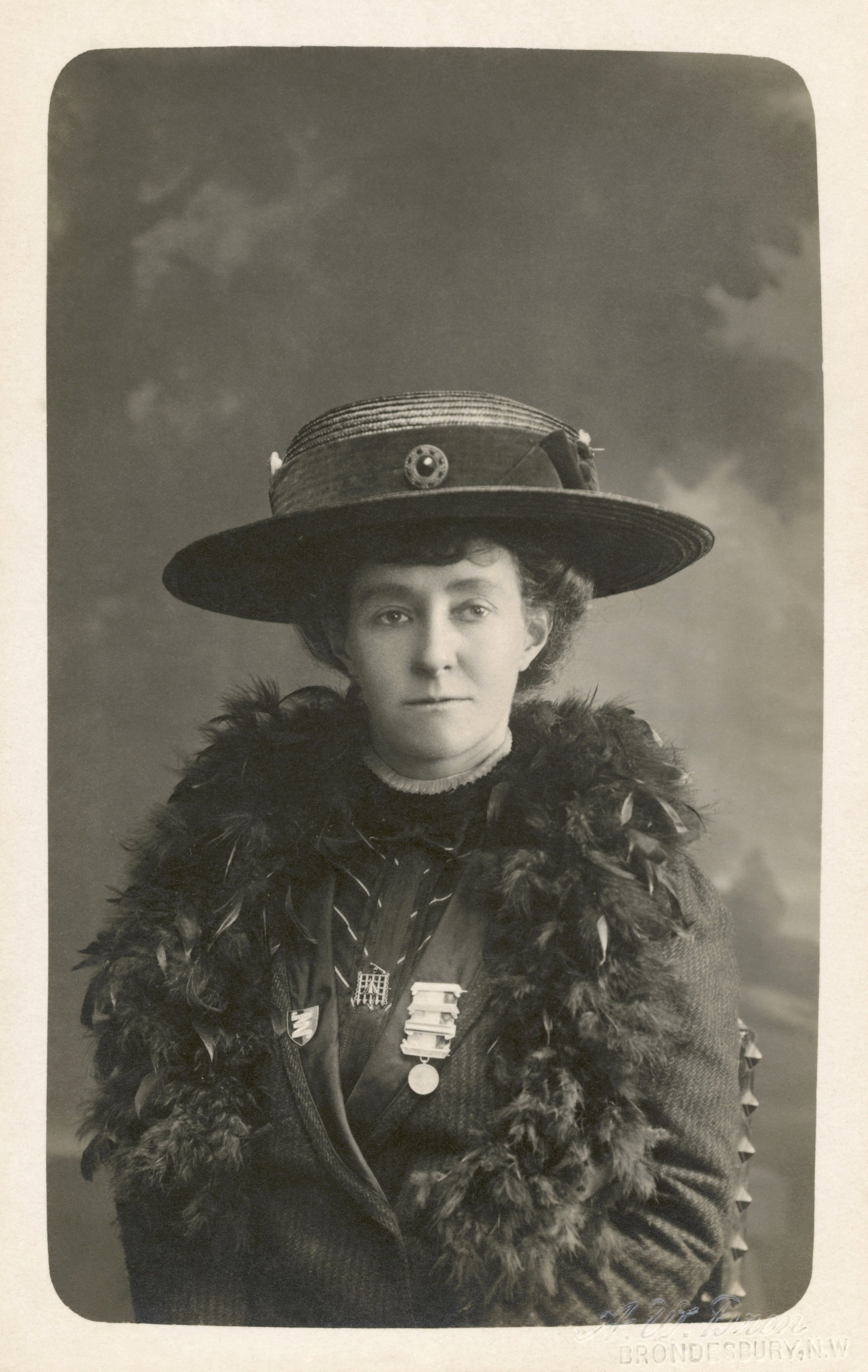|
Statue Of Millicent Fawcett
The statue of Millicent Fawcett in Parliament Square, London, honours the British suffragist leader and social campaigner Dame Millicent Fawcett. It was made in 2018 by Gillian Wearing. Following a campaign and petition by the activist Caroline Criado Perez, the statue's creation was endorsed by both the Prime Minister of the United Kingdom, Theresa May, and the Mayor of London, Sadiq Khan. The statue, Parliament Square's first monument to a woman and also its first sculpture by a woman, was funded through the government's Centenary Fund, which marks 100 years since some women won the right to vote. The memorial was unveiled on 24 April 2018. Description The bronze statue portrays Dame Millicent at the age of 50, when she became president of the National Union of Women's Suffrage Societies (NUWSS). The figure holds a banner reading COURAGE/ CALLS TO/ COURAGE/ EVERYWHERE, an extract from a speech Fawcett gave in 1920. She wears a walking suit, typical attire of that period f ... [...More Info...] [...Related Items...] OR: [Wikipedia] [Google] [Baidu] [Amazon] |
Gillian Wearing
Gillian Wearing CBE, RA (born 10 December 1963) is an English conceptual artist, one of the Young British Artists, and winner of the 1997 Turner Prize. In 2007 Wearing was elected as lifetime member of the Royal Academy of Arts in London. Her statue of the suffragist Millicent Fawcett stands in London's Parliament Square. From 5 November 2021 to 4 April 2022, the Solomon R. Guggenheim Museum in New York City showed ''Gillian Wearing: Wearing Masks'', the first retrospective of Wearing's work in North America. Early life Wearing was born in 1963 in Birmingham, England."Gillian Wearing" Tanya Bonakdar Gallery, Retrieved 20 November 2018. She attended Dartmouth High School in ... [...More Info...] [...Related Items...] OR: [Wikipedia] [Google] [Baidu] [Amazon] |
Plinth
A pedestal or plinth is a support at the bottom of a statue, vase, column, or certain altars. Smaller pedestals, especially if round in shape, may be called socles. In civil engineering, it is also called ''basement''. The minimum height of the plinth is usually kept as 45 cm (for buildings). It transmits loads from superstructure to the substructure and acts as the retaining wall for the filling inside the plinth or raised floor. In sculpting, the terms base, plinth, and pedestal are defined according to their subtle differences. A base is defined as a large mass that supports the sculpture from below. A plinth is defined as a flat and planar support which separates the sculpture from the environment. A pedestal, on the other hand, is defined as a shaft-like form that raises the sculpture and separates it from the base. An elevated pedestal or plinth that bears a statue, and which is raised from the substructure supporting it (typically roofs or corniches), is some ... [...More Info...] [...Related Items...] OR: [Wikipedia] [Google] [Baidu] [Amazon] |
Emily Wilding Davison
Emily Wilding Davison (11 October 1872 – 8 June 1913) was an English suffragette who fought for votes for women in Britain in the early twentieth century. A member of the Women's Social and Political Union (WSPU) and a militant fighter for her cause, she was arrested on nine occasions, went on hunger strike seven times and was force-fed on forty-nine occasions. She died after being hit by King George V's horse Anmer at the 1913 Derby when she walked onto the track during the race. Davison grew up in a middle-class family, and studied at Royal Holloway College, London, and St Hugh's College, Oxford, before taking jobs as a teacher and governess. She joined the WSPU in November 1906 and became an officer of the organisation and a chief steward during marches. She soon became known in the organisation for her militant action; her tactics included breaking windows, throwing stones, setting fire to postboxes, planting bombs and, on three occasions, hiding overnight ... [...More Info...] [...Related Items...] OR: [Wikipedia] [Google] [Baidu] [Amazon] |
Jessie Craigen
Jessie Hannah Craigen ( – 5 October 1899), was a British working-class suffrage speaker in a movement which was predominantly made up of middle and upper-class activists. She was also a freelance (or 'paid agent') speaker in the campaigns for Irish Home Rule and the cooperative movement and against vivisection, compulsory vaccination, and the Contagious Diseases Acts. Early life It is not certain where in the UK she was born, although the ''Dover Express'' in 1866 described her as a 'Scotch lady'. The 1871 census, however, shows her living with an adopted 18-year-old child, Rosetta Vincent, and a married sister, Emma Henley, in Ordsall near Retford and describing herself as a ‘lecturer’, born in London. By 1881 she is in Clifton, Bristol, and in the census she describes herself as a London-born, ‘Lecturer on Social Subjects’. She reportedly had a seafaring father from the Scottish Highlands, who died when she was an infant, and a mother who was an Italian actress. ... [...More Info...] [...Related Items...] OR: [Wikipedia] [Google] [Baidu] [Amazon] |
Frances Power Cobbe
Frances Power Cobbe (4 December 1822 – 5 April 1904) was an Anglo-Irish writer, philosopher, religious thinker, social reformer, anti-vivisection activist and leading women's suffrage campaigner. She founded a number of animal advocacy groups, including the National Anti-Vivisection Society (NAVS) in 1875 and the British Union for the Abolition of Vivisection (BUAV) in 1898, and was a member of the executive council of the London National Society for Women's Suffrage. Life Frances Power Cobbe was a member of the prominent Cobbe family, descended from Archbishop Charles Cobbe, Primate of Ireland. She was born in Newbridge House in the family estate in present-day Donabate, County Dublin. Cobbe was educated mainly at home by governesses with a brief period at a school in Brighton. She studied English literature, French, German, Italian, music, and the Bible. She then read heavily in the family library especially in religion and theology, joined several subscription libra ... [...More Info...] [...Related Items...] OR: [Wikipedia] [Google] [Baidu] [Amazon] |

